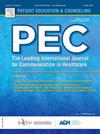Experiences of patient-provider concordance in healthcare among All of Us participants, 2017–2023
IF 2.9
2区 医学
Q2 PUBLIC, ENVIRONMENTAL & OCCUPATIONAL HEALTH
引用次数: 0
Abstract
Objective
To examine differences in care experiences and preferences related to patient-provider relationships across both cultural and personal patient identities.
Methods
Logistic regression was used to test the associations between patient characteristics and patient survey responses using 2017–2023 data from the All of Us dataset.
Results
Nearly two thirds of the All of Us participants considered it important that their providers were like them (63.2 %) and could often see them (66.3 %). The odds of reporting that it was important that their providers were like them were higher among all groups compared to non-Hispanic White participants (non-Hispanic Black: aOR 2.59 95% Confidence Interval (CI) [2.41–2.78]; Hispanic: aOR 1.42 95% CI [1.33–1.51]; non-Hispanic Asian: aOR 1.45 95% CI [1.33–1.59]; non-Hispanic Other: aOR 1.16 95% CI [1.08–1.25]). Female participants (aOR 1.29 95% CI [1.25–1.33]), those that spoke a language other than English at home (aOR 1.45 95% CI [1.38–1.53]), those with Medicaid (aOR 1.23 95% CI [1.15–1.32]) or no insurance (aOR 1.17 95% CI [1.10–1.25]) compared to those privately insured, and those with a disability (aOR 1.15 95% CI [1.11–1.20]) were more likely to report that it was very/somewhat important their provider be similar to them.
Conclusions
The results of this study suggest that the dimensions of patient identity contribute to inequities in receiving culturally concordant care.
Practice implications
The significant subgroup differences across all survey questions suggest that previous interventions addressing cultural competence in providers may not reach all the patient populations. Instead of a one-size-fits-all approach to improving the care experiences of different patient populations, adopting the key behaviors derived from both patient-centered and culturally competent care and by using the guiding principles of cultural humility would enable providers to tailor care that is centered on patient needs and preferences.
2017-2023年我们所有参与者在医疗保健中患者-提供者一致性的经验
目的研究不同文化背景和患者个人身份下与患者-提供者关系相关的护理经验和偏好的差异。方法使用All of Us数据集2017-2023年的数据,采用logistic回归方法检验患者特征与患者调查反应之间的相关性。结果近三分之二的All Us参与者认为他们的提供者和他们一样(63.2 %)并且经常可以看到他们(66.3% %)是重要的。与非西班牙裔白人参与者(非西班牙裔黑人:aOR 2.59 95%置信区间(CI) [2.41-2.78];西班牙裔:aOR 1.42 95% CI [1.33-1.51];非西班牙裔亚洲人:aOR 1.45 95% CI [1.33-1.59];非西班牙裔其他:aOR 1.16 95% CI[1.08-1.25])。女性参与者(aOR 1.29 95% CI[1.25-1.33])、在家说英语以外语言的参与者(aOR 1.45 95% CI[1.38-1.53])、有医疗补助的参与者(aOR 1.23 95% CI[1.15 - 1.32])或没有保险的参与者(aOR 1.17 95% CI[1.10-1.25])与私人保险的参与者相比,残疾参与者(aOR 1.15 95% CI[1.11-1.20])更有可能报告说,他们的提供者与他们相似是非常/有些重要的。结论本研究的结果表明,患者认同的维度有助于接受文化和谐护理的不平等。实践意义所有调查问题的显著亚组差异表明,先前针对提供者文化能力的干预措施可能无法覆盖所有患者群体。与其采用一刀切的方法来改善不同患者群体的护理体验,不如采用以患者为中心和文化主管护理的关键行为,并通过使用文化谦逊的指导原则,使提供者能够以患者的需求和偏好为中心量身定制护理。
本文章由计算机程序翻译,如有差异,请以英文原文为准。
求助全文
约1分钟内获得全文
求助全文
来源期刊

Patient Education and Counseling
医学-公共卫生、环境卫生与职业卫生
CiteScore
5.60
自引率
11.40%
发文量
384
审稿时长
46 days
期刊介绍:
Patient Education and Counseling is an interdisciplinary, international journal for patient education and health promotion researchers, managers and clinicians. The journal seeks to explore and elucidate the educational, counseling and communication models in health care. Its aim is to provide a forum for fundamental as well as applied research, and to promote the study of organizational issues involved with the delivery of patient education, counseling, health promotion services and training models in improving communication between providers and patients.
 求助内容:
求助内容: 应助结果提醒方式:
应助结果提醒方式:


